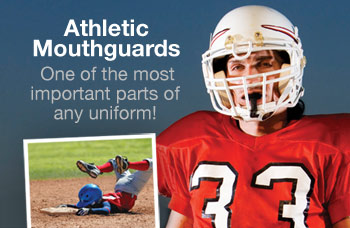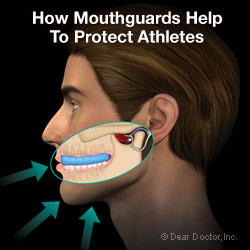Athletic Mouthguards
One of the most important parts of any uniform!

There are times when an athlete can feel invincible... able to connect on every jump-shot, run faster and longer, or hit every pitch, but statistics show that even on their best days accidents can happen. An ounce of prevention goes a long way... For a small cost a properly fitted protective mouthguard can prevent anxiety, risk, injury, pain, suffering and years of dental treatment.
Not convinced? Read on!
Is there scientific evidence that mouthguards really work?
The journal, Sports Medicine published an important evidence-based report in 2007 on the topic of “Mouthguards and Sports Activities.” It included three systematic reviews on: 1) the history of mouthguard use in sports; 2) mouthguard material and design; and 3) the effectiveness of mouthguards in preventing oral-facial injuries and concussions. Here are the conclusions:
The first recorded use of mouthguards was by boxers, and in the 1920s professional boxing became the first sport to require mouthguards. Advocacy by the American Dental Association led to the mandating of mouthguards for US high school football in 1962. Currently, the US National Collegiate Athletic Association (NCAA) requires mouthguards for four sports (ice hockey, lacrosse, field hockey and football). However, the American Dental Association recommends the use of custom mouthguards in 29 sports/exercise activities.
Studies of the properties of mouthguard materials have included; shock-absorbing capability, hardness, stiffness (indicative of protective capability), strength (indicative of durability) and water absorption (indicative of fit and stability). Latex rubber was a popular material used in early mouthguards but it has lower shock absorbency, lower hardness and less tear and tensile strength than Ethylene Vinyl Acetate (EVA) or polyurethane (PU). EVA and PU, the transparent copolymer plastics used for shock absorption and padding in today's sports equipment are far superior in durability and flexibility. Among the more modern materials, none seems to stand out as superior, since most of them can be manipulated to provide a range of favorable characteristics. Impact studies have shown that compared with no mouthguard, mouthguards composed of many types of materials reduce the number of fractured teeth.
Mouthguard design considerations must include the nature of anticipated collision (with hard or soft objects) and characteristics of mouth size and shape, the hard structure of the teeth and soft gum and lip tissues. Laminated (layered) mouthguards (as we will discuss later), with different shock absorbing and stress distributing capabilities may be one way to accommodate these factors. Despite all the issues and difficulties comparing studies going back to the 1980s, analyses indicate that the risk of an oral-facial sports injury was 1.6-1.9 times higher when a mouthguard was not worn.
Mouthguard effectiveness, bottom line — the strong conclusion of the review was that mouthguards should be worn in sport activities where there is significant risk of injury to the mouth, teeth and face, although protection against concussion is inconsistent. Yes they work!
 |
| Mouthguards are designed to absorb and distribute the forces of impact received while participating in athletic activities.
Click to enlarge |
Are some types of mouthguards on the market better than others?
There are many different designs and types of guards available “over-the-counter” from retail stores. They generally fall into two categories:
Stock mouthguards: The lowest cost option is an item that can be bought “off the shelf” from a drug or sporting goods store. This type of mouthguard offers the least protection because there is no fit adjustment. The stock mouthguard comes in limited sizes (usually small, medium, and large). They are the least expensive and least protective; prices range approximately from $3 to $25. While better than nothing, a stock mouthguard is not considered acceptable as a facial protective device.
Mouth-formed protectors: These mouthguards come as a “shell-liner” or “boil-and-bite” product from sporting goods stores. The shell is lined with acrylic or rubber. Presently, this is the most commonly used mouthguard on the market. Made from thermoplastic (moldable when heated) material, they are immersed in boiling water and formed in the mouth by using finger, tongue, and biting pressure. Available in limited sizes, these mouthguards lack proper extensions and often do not cover all the back teeth.




